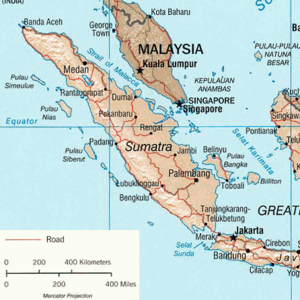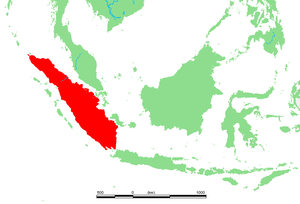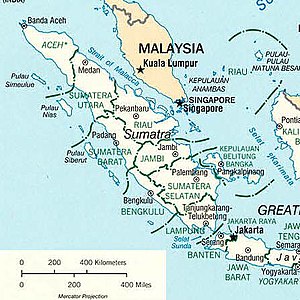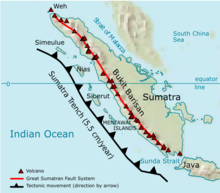Sumatra
| Sumatra | |
|---|---|
| Waters | Indian Ocean , Strait of Malacca , South China Sea , Java Sea |
| Archipelago | Great Sunda Islands |
| Geographical location | 0 ° S , 102 ° E |
| length | 1 700 km |
| width | 370 km |
| surface | 473,481 km² |
| Highest elevation |
Kerinchi 3805 m |
| Residents | 50,365,538 (2010) 106 inhabitants / km² |
| main place | Medan |
The island of Sumatra (pronounced Sumátra or Súmatra) or Sumatera (outdated Indonesian spelling) belongs to Indonesia and is the sixth largest island in the world with 473,481 km² . The offshore islands with a total of 50,000 km² are included in this area.
geography
The island extends 1700 kilometers in a northwest-southeast direction and is up to 370 kilometers wide, the equator crosses the center of the island. The Barisan Mountains (Gunung Barisan) accompany the west coast and get higher and higher towards the southeast. The Gunung Kerinci rises up to 3805 meters. But there are other three thousand meter peaks . Volcanic activities in these mountains endowed the island with fertile land and picturesque landscapes (around Lake Toba ). The eastern half of the island is flat; the plain, up to 300 km wide, is almost half covered with swamps .
location
Sumatra forms the extreme west of the populous state of Indonesia, which stretches with its main islands in a 5000 km long chain from Sumatra via Java , Bali and West Flores to the Moluccas off New Guinea .
Southeast of Sumatra is the main island of Java, separated by the 40 kilometers wide Sunda Strait . In the southern Sunda Strait there are some volcanic islands, including Krakatau (816 m, with devastating eruptions in 1883 and 1930). Lake Toba in the north of the island is the remnant of a super volcanic eruption around 75,000 years ago, which, according to Stanley H. Ambrose, only 1000 to 10,000 people worldwide should have survived and which is said to have almost wiped out humanity (see Toba catastrophe theory ).
Offshore islands
In the east, on the Strait of Malacca, there are some flat islands (Indonesian: 'Pulau') on the coast, separated only by narrow inlets:
- Rupat (with the largest town Batupanjang)
- Bengkalis (with the capital of the same name)
- Padang
- Rank
- Rantau
- Penyeler (with the main town Mendung), right in front of the mouth of the Kampar River
The island of Kundur , east of Penyeler, already belongs to the Riau Islands ( Kepulauan Riau ).
Other islands lie in front of the mouth of the Indragiri , near the city of Tembilahan. A little to the south, in front of the mouth of the Batang Hari , are two small islands.
A long way south of the east coast are the large islands of Bangka and Belitung . Beyond the 600 km wide sea in the east (Selat Kerimata) lies the island of Borneo . To the east of the busy, narrow Strait of Malacca is the Malay Peninsula with Singapore , with the Riau Islands a little south of it .
The island of Weh lies directly in front of the headland of Aceh in the north-west , another 200 km to the north is Great Nicobar, the southernmost island of the Andaman and Nicobar archipelago , which already belongs to India .
Off the southwest coast of Sumatra are a number of islands (Indonesian: 'Pulau'), starting in the north:
- Simeuluë
- Banyak islands with the larger islands of Balai, Tuangku, Bangkaru and Palambak
- Nias
- Batu Islands with three larger ( Tanahbala , Tanahmasa and Pini ) and 48 smaller islands
- Mentawai Islands with Siberut , Sipora , North Pagai and South Pagai
- Mega
- Enggano
The volcanic island of Krakatau , Legundi , Sebuku and Sebesi are located in the Sunda Strait in the south of Sumatra . The neighboring Panaitan and Sangiang are already closer to Java.
Administrative division
Sumatra (and the surrounding islands) are divided into a total of 10 provinces, which in turn are further subdivided into administrative districts and cities ( Kabupaten and Kota ):
- Aceh (extreme north-west, with the island of Simeuluë ), capital Banda Aceh , enjoys special privileges as a special region
- Bangka-Belitung (two islands towards Borneo), capital Pangkal Pinang
- Bengkulu (southern coast), capital of Bengkulu
- Jambi (Middle-East), capital Jambi
- Lampung (southeastern tip towards Java), capital Bandar Lampung
- Riau (middle plain, on the strait to Singapore), capital Pekanbaru
- Kepulauan Riau (Riau Islands), capital Tanjung Pinang
- Sumatra Barat (middle west coast), capital Padang
- Sumatra Selatan (South Sumatra), capital Palembang
- Sumatra Utara (northwest Sumatra, with the island of Nias ), capital Medan
geology
The Sunda Trench runs along the southwest coast of Sumatra . The tectonics of the western center of Sumatra is shaped by the northward movement of the Australian plate . The plate boundary runs roughly along the Sunda Trench, but the zone where deformations occur extends hundreds of kilometers from the trench. This causes earthquakes to occur again and again:
- Earthquake of June 28, 1926
- Earthquake of June 8th and 9th, 1943
- Earthquake of June 4, 2000
- Seaquake of December 26, 2004
- Seaquake of March 28, 2005
- Earthquake of March 6, 2007
- Earthquake of September 12, 2007
- Seaquake of February 20, 2008
- Seaquake of September 30, 2009
- Earthquake on April 6, 2010
- Earthquake October 25, 2010
- Earthquake of April 11, 2012
Consequences of these earthquakes are described below. One consequence of these tectonic activities is the uplift of the Barisan Mountains along the southwest coast of Sumatra.
population
Around 50 million inhabitants (as of 2010) live on the island. The population density is around 106 inhabitants / square kilometer, which is about a tenth as high as in neighboring Java.
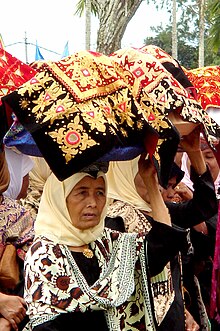
The most populous regions are around the cities of Medan and Palembang . Other big cities are Padang , Bandar Lampung and Pekanbaru .
The central government is promoting (e) the relocation of millions of Javanese as part of the Transmigrasi program, which is fueling the political climate.
The population is largely of Malay origin. It is divided into over 50 different languages, which are, however, quite similar to each other. The Malay language dominates in the east. In the mountainous west, for example, there are the Minangkabau , who are particularly known for their matrilineal social order, as well as the Lampung , the Batak and the Achinese . Some Chinese , Arabs and Indians live in the cities .
About 80% of the population professes Islam and 18% believes in Christianity . The remainder is distributed between Buddhist and 0.2% Hindu and ethnically religious communities at 0.7% . In 2007, the Islamic legal system was introduced in Aceh and partly in other provinces . Among other things, this right stipulates that the female population must wear a veil.
economy
There are significant oil deposits on Sumatra . The island generates 70% of the income of Indonesia. Mining plays an important role; coal , gold , bauxite and tin are all mined . Rubber , pepper , coffee , palm oil and tobacco play a role in agricultural products . International investors have massively expanded palm oil production in Indonesia since the mid-1990s. Today the island nation is the second largest producer after Malaysia. The forests of the indigenous people of Sumatra have to give way to plantations. The development of the island was also the completed in the 1980 Trans-Sumatran Highway advanced, the Banda Aceh on the northern tip about Medan , Prapat and Padang with Bandar Lampung and port of bakauheni connects at the southern tip.
Some important is also the tourism one - especially in the area of Lake Toba and around Bukittinggi .
history
The oldest evidence for the presence of anatomically modern humans ( Homo sapiens ) is around 70,000 years old.
The original name of Sumatra was Swarna Dwipa ("island of gold"), it comes from the gold export that came from the highlands of Sumatra in early times . In the first millennium AD, Buddhism and Hinduism gained a foothold on the island and merged with beliefs from the original peasant culture. Several empires were formed based on the culture imported from India. With its location on the sea trade route from India to China , trading cities soon began to flourish, the most famous being Srivijaya on the site of today's Palembang .
In the 11th century parts of the island fell under Javanese influence and at the same time, based on Indian traders, Islam began to spread, but it was not until the 13th century that it became established in larger parts of northern Sumatra. Smaller sultanates emerged, the best known being Aceh in the north.

The first trading contacts to Europe were made through Portuguese traders from small trading bases. The actual colonial conquest only began in 1596 with the landing of the Dutch on the island. One after another they subjugated all the sultanates, with Aceh not being completely defeated until 1905. The Dutch prevailed against the British in Sumatra, which was confirmed in the British-Dutch Treaty of 1824 .
At the end of the 19th century, new, "modern" plantations were created around the world . Their characteristics: they were located in remote areas, money and management came from different countries (Europe and USA), new scientific knowledge for yield optimization was applied and in addition to a few specialists, many unskilled workers were required. A center of this development was East Sumatra with its tobacco plantations. The land had been bought from the local princes, the recruited Chinese workers lived in camps, and huge areas with their own judiciary were created. In 1913 only half of the investments came from the Netherlands, the rest from Great Britain, the USA, Switzerland, France and Belgium.
During World War II , the island was occupied by the Japanese and then became part of the Republic of Indonesia. However, Sumatra's unrest continues to be the Aceh region in the north, which is striving for independence.
nature
Excessive clearing of forests, dynamite fishing , the hunt for fine skins, the demand for exotic souvenirs (such as turtle shells) mean that a large part of the flora and fauna is threatened with extinction. 140 native animal species are already legally protected, but nobody can effectively control them (even in reservations), and there is widespread corruption. To ensure survival, the Indonesian government has already declared 64,000 km² of protected areas in the entire archipelago . That is almost the size of ¾ the island of Java. Some of these nature parks also exist on Sumatra. The best known are the Gunung Leuser National Park in the north, the Rimbo Panti and Lembah Harau nature reserves near Bukittinggi and the Kerinchi-Seblat National Park in the south. They are administered by the PHPA (Perlindenan = protection, Hutan = forest, Pengawetan = conservation, Alam = nature). With 176 different mammals , 194 reptiles , 62 amphibians and 320 bird species, Sumatra presents a great variety of animal and plant life, more than on any other island in Indonesia.
Due to its equatorial location, Sumatra was covered by tropical rainforest until recently . It was not until the colonial period, and increasingly since the 1950s, that the evergreen forests were pushed back into the inaccessible mountain regions by extensive deforestation. In the meantime, most of the lowland rainforests have been destroyed, mostly by small farmers for their shifting cultivation or by companies to set up palm oil plantations. In 1998 these fires got out of hand and raged for months. The smoke was so strong that airports in the region had to be closed.
In schools and other initiatives, timid attempts are being made to introduce the children, young people and adult residents to the first steps towards ecological behavior in order to prevent further deforestation .
In the river Kampar a strong occurs tidal wave on which Bono is called and can move h up to 40 km /.
animals and plants
The remnants of Sumatra's overwhelming rainforests are famous around the world as they are home to some of the most endangered and rarest species on earth. You will u. a. inhabited by the hornbill ( Buceros spp. , indon. enggang), bigeye pheasant ( Argus pheasants , indon. burung kuau / kuang), Sumatra elephants (indon. gajah) and 8 different primate species . The agile and often aggressive Thomas langurs ( Presbytis thomasii ), the porcupine monkey ( Macaca nemestrina ) and the crab monkey ( Macaca fascicularis ), the Siamang ( Symphalangus syndactylus ) and the white-handed gibbon ( Hylobates lar , indon. Ungko) are also often observed. The latter are characterized by a wreath of white hair that frames the dark face. The always black hands and feet are always white on the top. The 6 to 8 kg monkeys are only found in Thailand , the Malay Peninsula and Sumatra.

The Sumatran orangutan ( Pongo abelii ) is the species of the genus orangutans that lives on Sumatra - the second species of the genus lives on Borneo . The smallest subspecies of the tiger, the endangered Sumatran tiger (indon. Macan ), which is characterized by a particularly strong color, is only rarely seen . The endangered Sumatran rhinoceros , the smallest species of rhinoceros in the world, are also at home here, as are saddleback tapirs .
3500 plant species were counted in the park. Rafflesia atjehensis can be found on the Alas and Bengkung rivers and on Bangko Lake . In a distribution area of 1 ° north and south of the equator, the titan arum ( Amorphophallus titanum ), with the largest inflorescence in the world, can also be seen. There are also many endemic orchid species, ferns and mosses.
World heritage
The tropical rainforests of Sumatra in 2004 as a natural monument in the UNESCO the list World Heritage added. The 25,951 km² area of the world heritage site includes the Gunung Leuser , Kerinchi-Seblat and Barisan Selatan national parks .
Natural disasters

- Large parts of the northwest province of Aceh were destroyed on December 26, 2004 by the devastating seaquake in the Indian Ocean and the subsequent tsunami . Authorities spoke of more than 150,000 victims in early 2005. According to official figures, more than 94,000 people are killed on the particularly hard hit island of Sumatra alone. However, the severity of the disaster was hushed up by the Javanese authorities for a few days, which is why the hard-to-reach west coast was only reached very late by aid workers.
- An aftershock on March 28, 2005 with an epicenter 200 kilometers west of Sumatra caused considerable damage on some islands off Sumatra, claimed numerous lives and reactivated some volcanoes on Sumatra.
- An earthquake in Sumatra on March 6, 2007, with an epicenter near the city of Solok in Western Sumatra, cost around 70 deaths according to previous knowledge (March 6, 2007).
- On September 12, 2007 an earthquake occurred off Sumatra with a strength of 7.8 M w . Numerous buildings were destroyed in the cities of Padang and Mukomuko.
- On September 30, 2009, Sumatra was hit again by a severe earthquake measuring 7.6 M w . Thousands of people were buried, and the relief work was made more difficult by a severe aftershock with a magnitude of 6.6 M w with an epicenter 900 km further southeast only 15 hours later. In Padang alone, 376 fatalities were rescued after 24 hours.
- On October 25, 2010, an earthquake off the west coast caused a local tsunami up to 3 m high that hit the Mentawai Islands . 20,000 people were made homeless and well over 400 people died.
food and drinks
Western fast-food restaurants and their Indonesian counterparts are gaining ground in the larger cities and tourist centers. Some traditional food cultures have survived in the rural areas. Still, fish and rice remain the staple foods, even in the mountainous regions.
Makanan padang
Makanan padang is very hot due to the generous use of chilli . This seasoning comes from times when there were no cooling options. It comes from the Muslim cuisine mainly from the Padang area and therefore mainly uses fish ( ikan ), chicken ( ayam ) and beef ( sapi ). More rarely there are lamb ( domba ), goat ( kambing ) and buffalo ( banteng / kerbau ), only a few ducks ( bebek ) or pigeons ( merpati ). Pig ( babi ) is considered unclean by the Muslims , only the dog ( anjing ) is even lower - although it is also eaten in some areas. Rendang is derived from the dish . Traditionally, the selected dishes are placed on the table with different sauces. Only what is eaten is charged. Since this can also include expensive specialties, it is advisable to ask about the price before eating. This tradition is becoming less and less important in tourist areas, so you can find menus and drinks menus more and more frequently.
beverages
In addition to tropical fruit juices, there are also various alcoholic drinks as long as you are not in the very Muslim north.
- Tuak : The flower of the sugar palm (indon. Pohon aren ) is scratched and the juice that escapes is collected in vessels. The liquid then ferments for a few days and develops a mediocre alcohol content (less than beer). Most people drink from bamboo canes. In the evening you meet at certain places (indon. Tempat tuak ), sit around, smoke, talk and drink. Manufacturers sell the brew out of large plastic canisters. To get drunk, a European would have to eat quite a bit. But not the intoxication is the main thing when drinking Tuak, but the cozy get-together.
- Arrak : is distilled (distilled) from Tuak. The alcohol content is comparable to our grain. Arrak is hardly edible on its own, but tastes great in coffee (indon. Kopi arak) or hot chocolate.
- Beer (bir) : It is available almost everywhere except in northern Sumatra. In addition to Beck’s , Heineken and Carlsberg , the Indonesian brands Bintang and Anker are also on the market.
- Coffee from the cat : The kilogram of the most expensive coffee in the world costs several 100 euros. Each individual bean has previously been eaten and excreted by a crawling cat , the Fleckenmusang ( Paradoxurus hermaphroditus ). The Kopi Luwak variety comes exclusively from Indonesia from the islands of Sumatra, Java and Sulawesi .
See also
- Administrative division of Indonesia
- Portal: Indonesia
- List of earthquakes in Indonesia
- Sumatran double knife
Fiction
- Jürgen Alex: Sumatra - Samosir in Lake Toba - island on the island . In: mtv (Medical Tribune) 4/1980, ISSN 0343-5237
- Inge Schubart: Doctor in the jungle of Sumatra . ISBN 3-7987-0327-2 . (Biographical novel between 1950 and 1960)
- Ida Pfeiffer : Adventure Island World . ISBN 3-900478-70-8 (1851 journey of the then well-known Austrian travel writer through Borneo , Sumatra and Java)
- Max Dauthendey : Last Journey. From diaries, letters and records. 1925
- Hermann Hesse : From India . ISBN 3-518-37062-6 (travel records from Singapore via Malaysia to South Sumatra from 1911)
- VS Naipaul : Beyond Faith: A Journey into Another Islam. 1998
Movie
- Christina Kolb: The island of Sumatra - on the way from the Karohochland to Padang . Ed .: Saarländischer Rundfunk, ISBN 3-7919-0608-9
Web links
Individual evidence
- ↑ Kath.net : Indonesia: Catholics must wear a Muslim veil September 18, 2007.
- ^ Film "Fette Beute" , by Inge Altemeier , 2002, on YouTube.
- ↑ Kira E. Westaway et al .: An early modern human presence in Sumatra 73,000–63,000 years ago. In: Nature . Volume 548, 2017, pp. 322-325, doi: 10.1038 / nature23452 .
- ↑ Osterhammel, Jürgen: The transformation of the world; CH Beck Verlag, Munich 2009, pp. 971f
- ^ Andreas Zangger: Colonial Switzerland. A piece of global history between Europe and Southeast Asia (1860-1930) , Transcript Verlag, Bielefeld 2011, ISBN 978-3-8376-1796-2 , pp. 169 to 286.
- ^ Bono, the Wave of Kampar River. describeindonesia.com.
- ↑ UNESCO: Tropical Rainforest Heritage of Sumatra .
- ↑ Tagesschau : Number of dead rises to more than 400 ( memento of October 3, 2009 in the Internet Archive ) from October 1, 2009 (accessed on October 1, 2009).
- ↑ Tsunami Bulletin ( English ) Pacific Tsunami Warning Center. October 25, 2010. Retrieved November 1, 2010.
